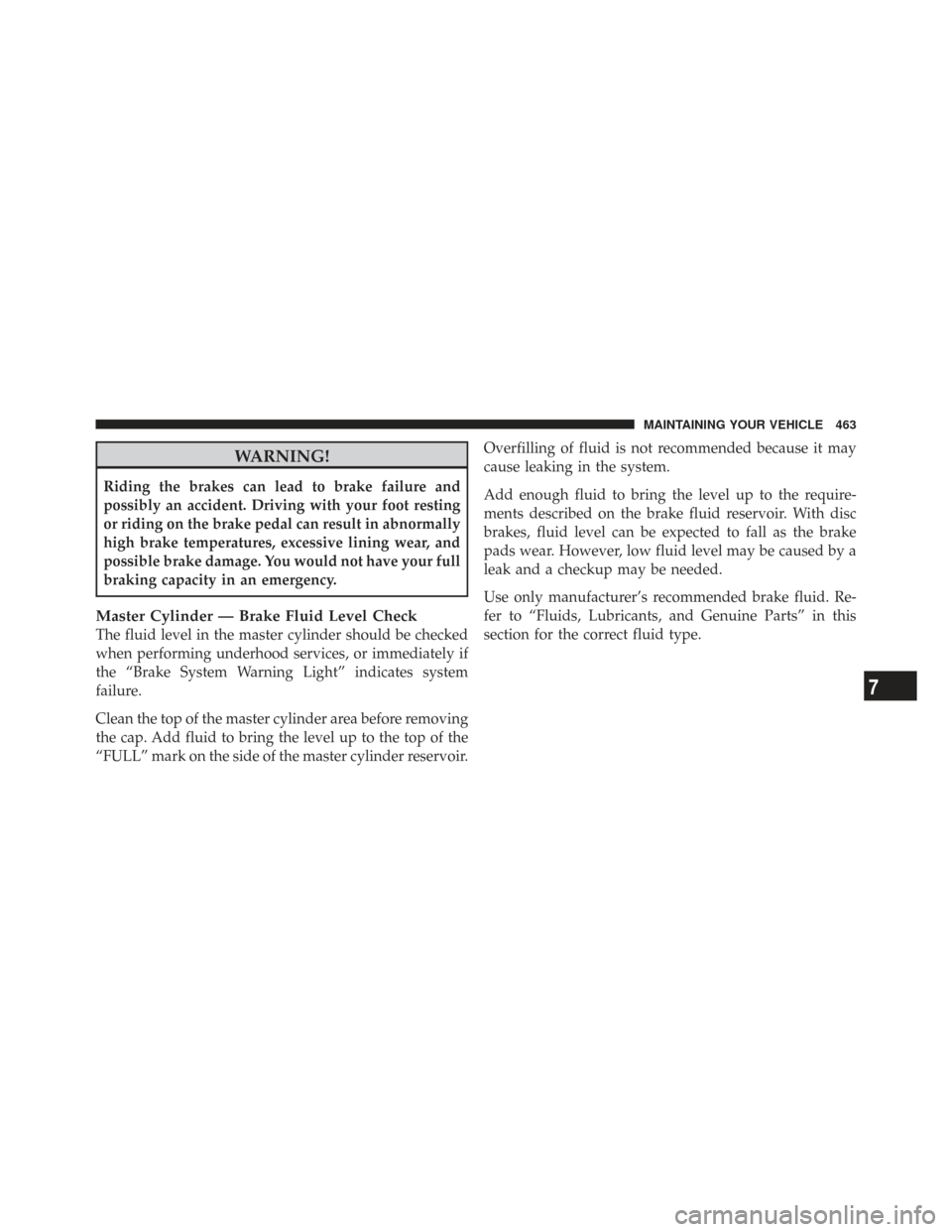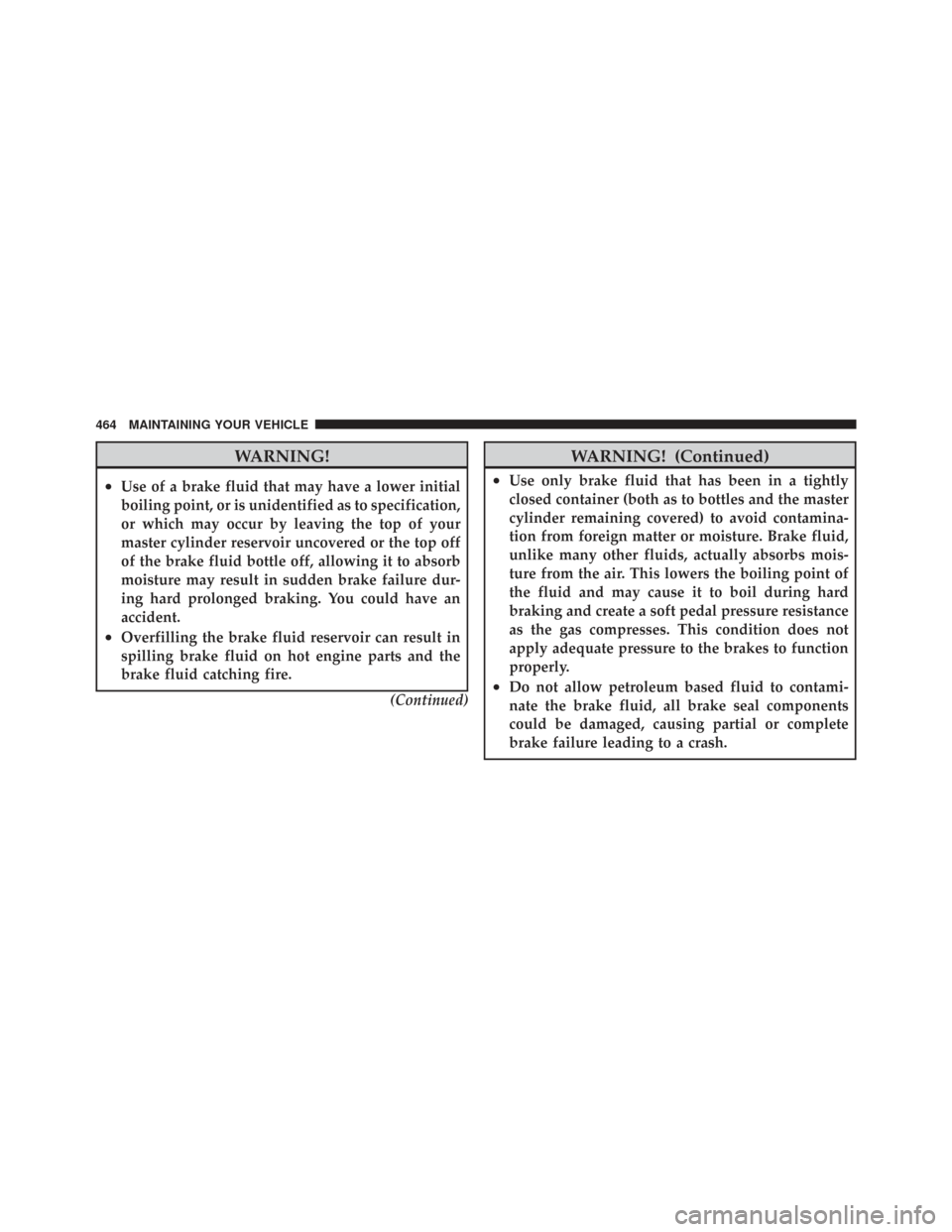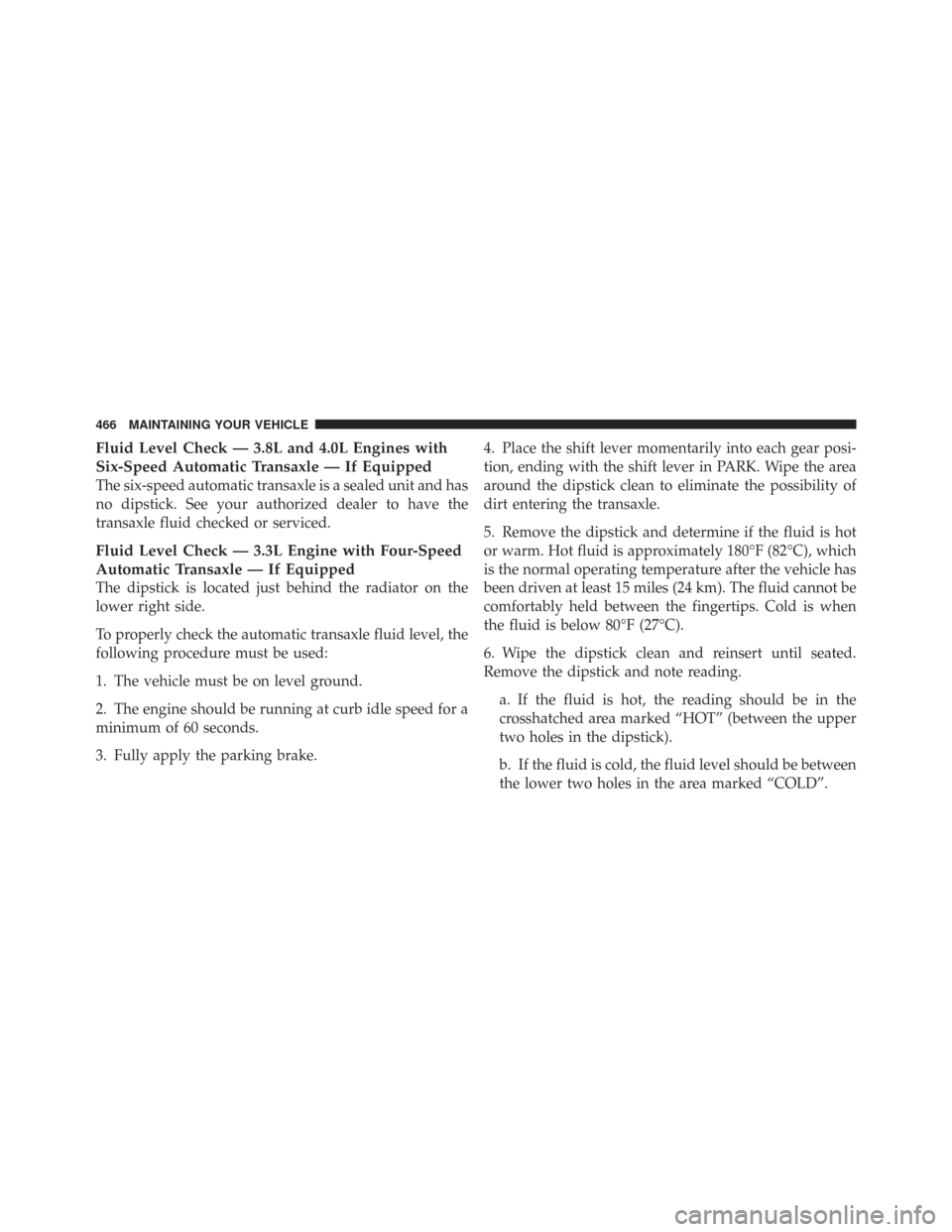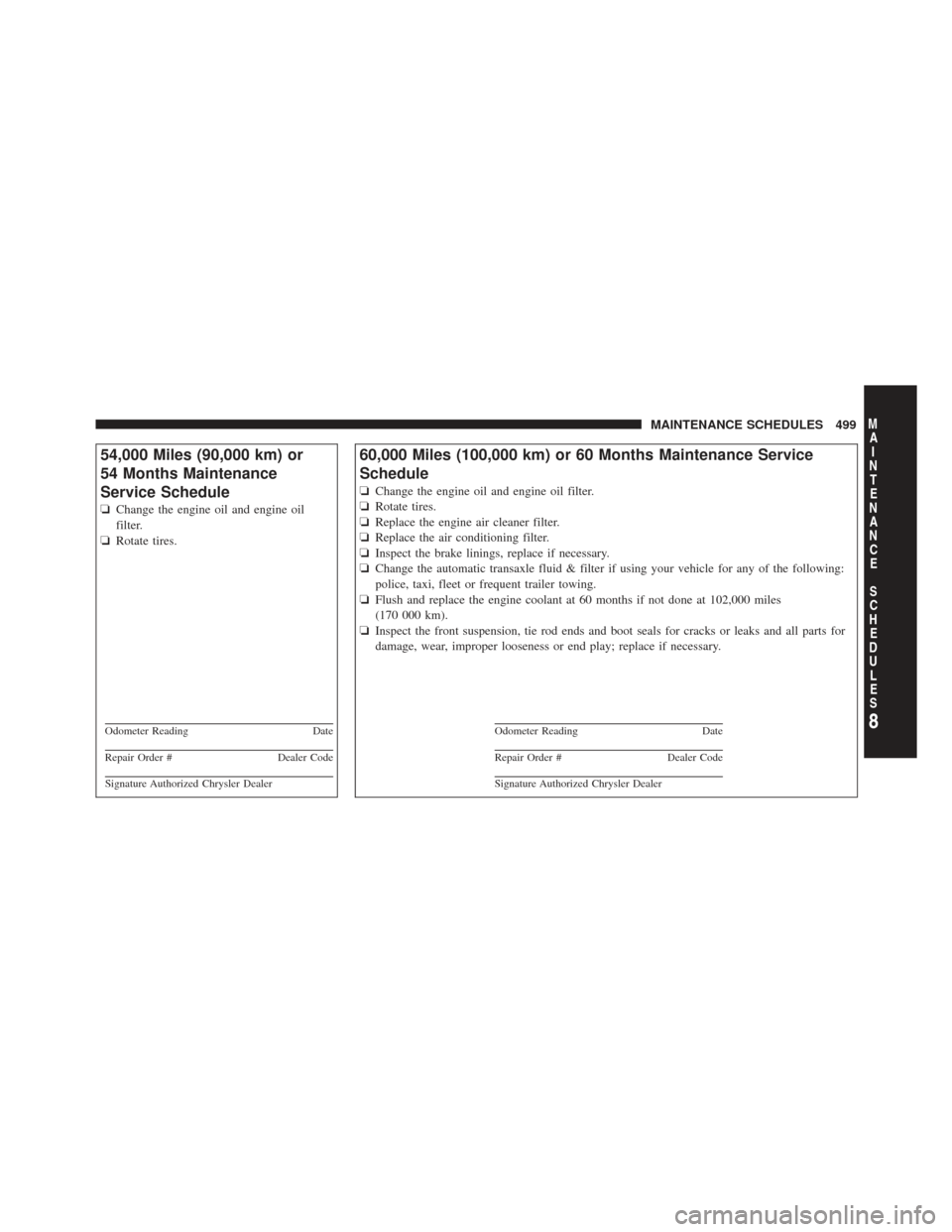Page 441 of 543
ENGINE COMPARTMENT — 3.3/3.8L
1 — Air Cleaner Filter7 — Engine Oil Fill
2 — Automatic Transmission Dipstick (3.3L Only) 8 — Engine Oil Dipstick
3 — Brake Fluid Reservoir 9 — Coolant Pressure Cap
4 — Battery 10 — Washer Fluid Reservoir
5 — Totally Integrated Power Module 11 — Power Steering Fluid Reservoir
6 — Engine Coolant Reservoir
7
MAINTAINING YOUR VEHICLE 439
Page 442 of 543
ENGINE COMPARTMENT — 4.0L
1 — Power Steering Fluid Reservoir7 — Engine Oil Dipstick
2 — Air Cleaner Filter 8 — Engine Oil Fill
3 — Brake Fluid Reservoir 9 — Coolant Pressure Cap
4 — Battery 10 — Washer Fluid Reservoir
5 — Totally Integrated Power Module
6 — Engine Coolant Reservoir
440 MAINTAINING YOUR VEHICLE
Page 465 of 543

WARNING!
Riding the brakes can lead to brake failure and
possibly an accident. Driving with your foot resting
or riding on the brake pedal can result in abnormally
high brake temperatures, excessive lining wear, and
possible brake damage. You would not have your full
braking capacity in an emergency.
Master Cylinder — Brake Fluid Level Check
The fluid level in the master cylinder should be checked
when performing underhood services, or immediately if
the “Brake System Warning Light” indicates system
failure.
Clean the top of the master cylinder area before removing
the cap. Add fluid to bring the level up to the top of the
“FULL” mark on the side of the master cylinder reservoir.Overfilling of fluid is not recommended because it may
cause leaking in the system.
Add enough fluid to bring the level up to the require-
ments described on the brake fluid reservoir. With disc
brakes, fluid level can be expected to fall as the brake
pads wear. However, low fluid level may be caused by a
leak and a checkup may be needed.
Use only manufacturer’s recommended brake fluid. Re-
fer to “Fluids, Lubricants, and Genuine Parts” in this
section for the correct fluid type.
7
MAINTAINING YOUR VEHICLE 463
Page 466 of 543

WARNING!
•Use of a brake fluid that may have a lower initial
boiling point, or is unidentified as to specification,
or which may occur by leaving the top of your
master cylinder reservoir uncovered or the top off
of the brake fluid bottle off, allowing it to absorb
moisture may result in sudden brake failure dur-
ing hard prolonged braking. You could have an
accident.
•Overfilling the brake fluid reservoir can result in
spilling brake fluid on hot engine parts and the
brake fluid catching fire.(Continued)
WARNING! (Continued)
•Use only brake fluid that has been in a tightly
closed container (both as to bottles and the master
cylinder remaining covered) to avoid contamina-
tion from foreign matter or moisture. Brake fluid,
unlike many other fluids, actually absorbs mois-
ture from the air. This lowers the boiling point of
the fluid and may cause it to boil during hard
braking and create a soft pedal pressure resistance
as the gas compresses. This condition does not
apply adequate pressure to the brakes to function
properly.
•Do not allow petroleum based fluid to contami-
nate the brake fluid, all brake seal components
could be damaged, causing partial or complete
brake failure leading to a crash.
464 MAINTAINING YOUR VEHICLE
Page 468 of 543

Fluid Level Check — 3.8L and 4.0L Engines with
Six-Speed Automatic Transaxle — If Equipped
The six-speed automatic transaxle is a sealed unit and has
no dipstick. See your authorized dealer to have the
transaxle fluid checked or serviced.
Fluid Level Check — 3.3L Engine with Four-Speed
Automatic Transaxle — If Equipped
The dipstick is located just behind the radiator on the
lower right side.
To properly check the automatic transaxle fluid level, the
following procedure must be used:
1. The vehicle must be on level ground.
2. The engine should be running at curb idle speed for a
minimum of 60 seconds.
3. Fully apply the parking brake.4. Place the shift lever momentarily into each gear posi-
tion, ending with the shift lever in PARK. Wipe the area
around the dipstick clean to eliminate the possibility of
dirt entering the transaxle.
5. Remove the dipstick and determine if the fluid is hot
or warm. Hot fluid is approximately 180°F (82°C), which
is the normal operating temperature after the vehicle has
been driven at least 15 miles (24 km). The fluid cannot be
comfortably held between the fingertips. Cold is when
the fluid is below 80°F (27°C).
6. Wipe the dipstick clean and reinsert until seated.
Remove the dipstick and note reading.
a. If the fluid is hot, the reading should be in the
crosshatched area marked “HOT” (between the upper
two holes in the dipstick).
b. If the fluid is cold, the fluid level should be between
the lower two holes in the area marked “COLD”.
466 MAINTAINING YOUR VEHICLE
Page 492 of 543
Chassis
ComponentFluid, Lubricant, or Genuine Part
Automatic Transaxle MOPAR�ATF+4 Automatic Transmission Fluid
Brake Master Cylinder MOPAR�
DOT 3 and SAE J1703 should be used or equivalent. If
DOT 3 brake fluid is not available, then DOT 4 is acceptable. Use
only recommended brake fluids.
Power Steering Reservoir MOPAR�
Power Steering Fluid +4, MOPAR� ATF+4 Automatic Trans-
mission Fluid
490 MAINTAINING YOUR VEHICLE
Page 496 of 543
•Check the fluid levels of the coolant reservoir, the
brake master cylinder, the power steering and the
transaxle and add as needed.
•Check all lights and other electrical items for correct
operation.
At Each Oil Change
•Change the engine oil filter.
•Inspect the brake hoses and lines.
CAUTION!
Failure to perform the required maintenance items
may result in damage to the vehicle.
Required Maintenance Intervals
Refer to the Maintenance Schedules on the following
pages for the required maintenance intervals.
8
M A I
N T
E
N A
N CE
S
C
H E
D
U L
E
S494 MAINTENANCE SCHEDULES
Page 501 of 543

54,000 Miles (90,000 km) or
54 Months Maintenance
Service Schedule
❏Change the engine oil and engine oil
filter.
❏ Rotate tires.
Odometer Reading Date
Repair Order #Dealer Code
Signature Authorized Chrysler Dealer
60,000 Miles (100,000 km) or 60 Months Maintenance Service
Schedule
❏Change the engine oil and engine oil filter.
❏ Rotate tires.
❏ Replace the engine air cleaner filter.
❏ Replace the air conditioning filter.
❏ Inspect the brake linings, replace if necessary.
❏ Change the automatic transaxle fluid & filter if using your vehicle for any of the following:
police, taxi, fleet or frequent trailer towing.
❏ Flush and replace the engine coolant at 60 months if not done at 102,000 miles
(170 000 km).
❏ Inspect the front suspension, tie rod ends and boot seals for cracks or leaks and all parts for
damage, wear, improper looseness or end play; replace if necessary.
Odometer Reading Date
Repair Order #Dealer Code
Signature Authorized Chrysler Dealer
8
M
A I
N T
E
N A
N CE
S
C
H E
D
U L
E
SMAINTENANCE SCHEDULES 499